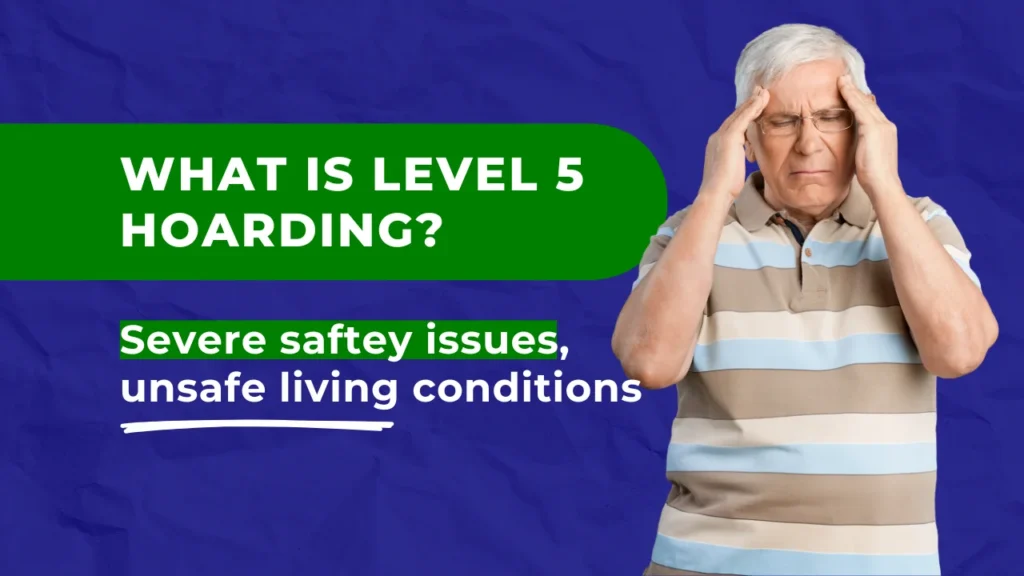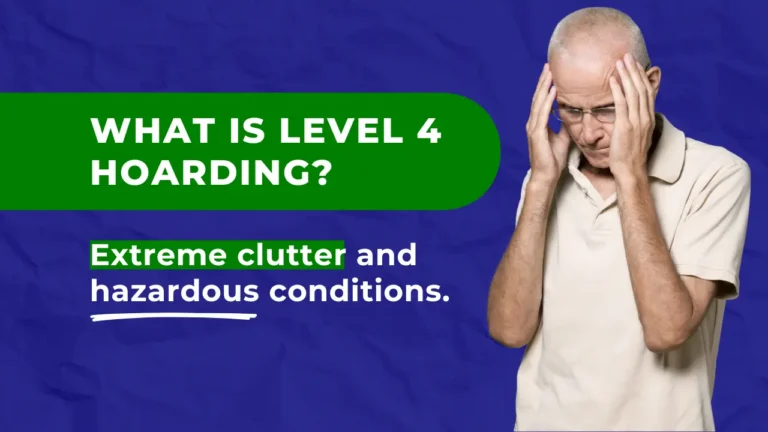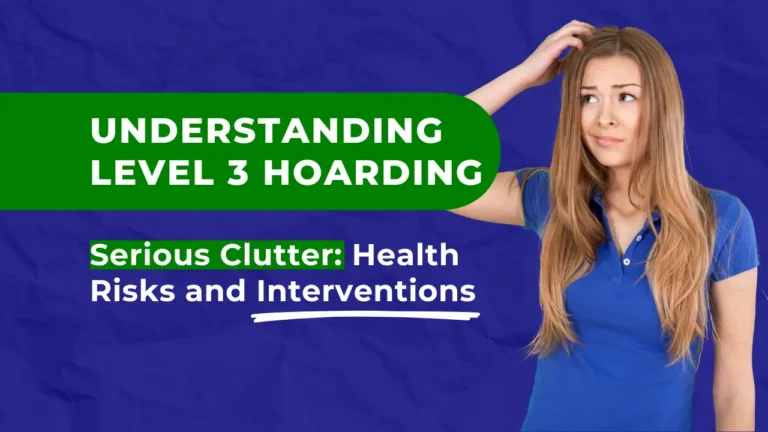You visit a cousin you haven’t seen in years, and right away you know something is wrong. The front door is nearly blocked by stacks of newspapers, magazines, and other items. Every available surface is covered with objects—some valuable, most not. The kitchen is inaccessible, with dishes piled high and the stove buried under a mix of papers, old mail, and grocery bags. The bathroom is unusable due to broken plumbing and the sheer volume of clutter. Even the air smells musty, with a mix of mold, dust, and decay lingering throughout the house.
This is not a simple case of disorganization- it’s a Level 5 hoarding situation. Homes like this pose major health and safety risks, making it difficult, if not impossible, for the person living there to carry out daily activities. There are 5 stages of hoarding and In this blog, we’ll explain what Stage 5 hoarding looks like, why it happens, and what steps you can take if you or someone you know is dealing with this condition.
The Clutter Hoarding Scale and the Five Levels of Hoarding
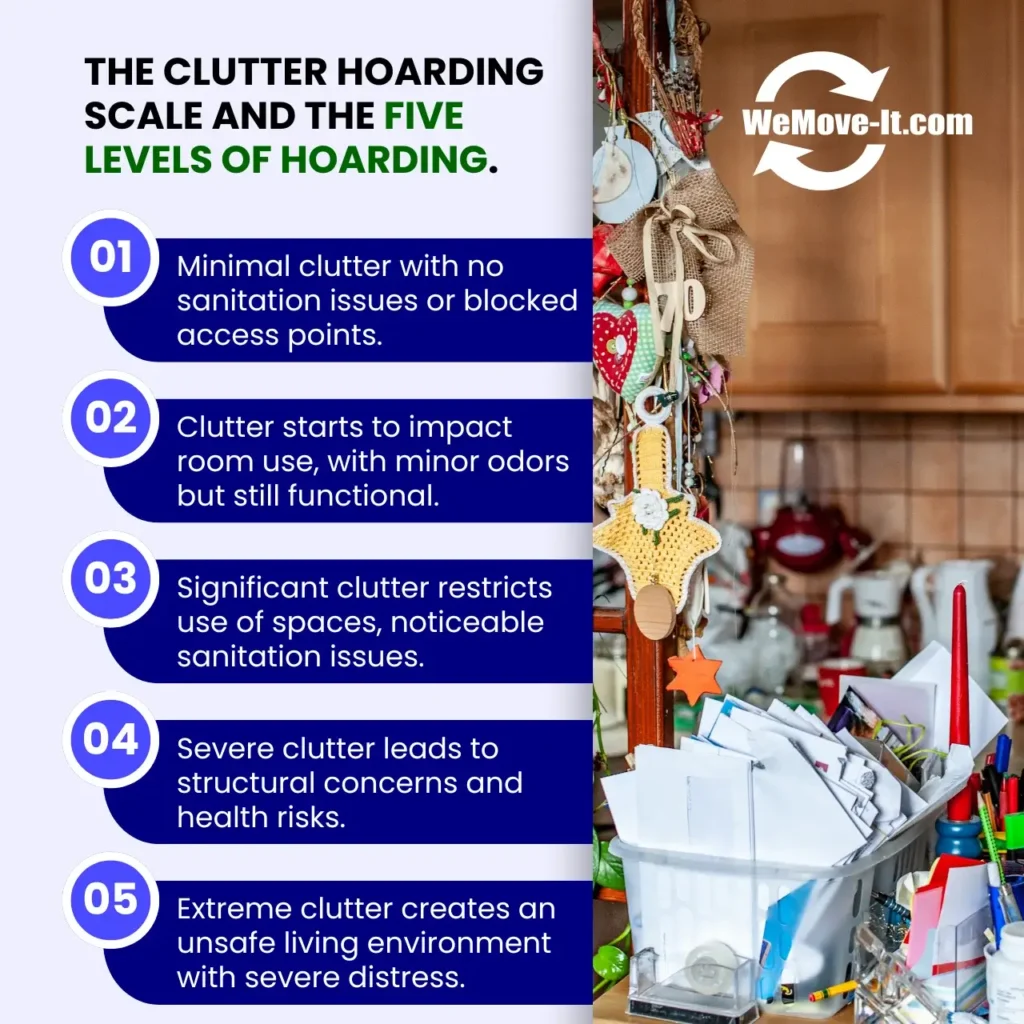
The Clutter Hoarding Scale is a tool used to assess the severity of a hoarding situation. It categorizes hoarding into five levels, with each level indicating the extent of clutter and associated risks.
- Level 1: This is the least severe form of hoarding. The home may have some clutter, but all doors and stairways are accessible and there are no noticeable sanitation issues. Items are generally in their proper place, and there’s no major risk to health or safety.
- Level 2: With Level 2 hoarding, clutter begins to accumulate. One or more rooms may be difficult to use due to the clutter, and there may be some minor sanitation issues, such as unpleasant odours. However, the home is still generally safe and functional.
- Level 3: Level 3 hoarding involves more significant clutter which can make some parts of the home unusable. Sanitation issues become more apparent, with possible signs of mold, pests, or pet damage. The person may also begin to withdraw socially.
- Level 4: At hoarding Level 4, the home is heavily cluttered, with sanitation concerns, potential structural damage, and infestations. Living spaces are severely limited, and the individual’s mental and physical health may be deteriorating.
- Level 5: This is the most severe level of hoarding on the Clutter Hoarding Scale. The home is not only cluttered but may also be unsafe to live in. The individual may also be isolated and experiencing severe emotional distress.
What Does Level 5 Hoarding Look Like?
Stage 5 hoarding is a critical situation. If you’ve never encountered it and are trying to picture what it looks like, imagine a home where clutter has taken over every room. Doors and windows might be blocked, making it difficult to move around or even get in and out of the house. Furniture is buried under piles of items, often making it unusable. Essential areas like the kitchen and bathroom might be inaccessible or too hazardous to use.
In some Level 5 hoarding situations, you might find electrical hazards, such as frayed wires or overloaded outlets, which can be a fire risk. The plumbing system may have failed, leading to sewage backups or a lack of running water. Structural damage to the home is common, with walls, floors, or ceilings at risk of collapsing due to the weight of accumulated items. The presence of biohazards, such as rotting food, human or animal waste, and the remains of dead animals, also creates a dangerous environment that requires specialized cleanup.
Why Does Stage 5 Hoarding Happen?
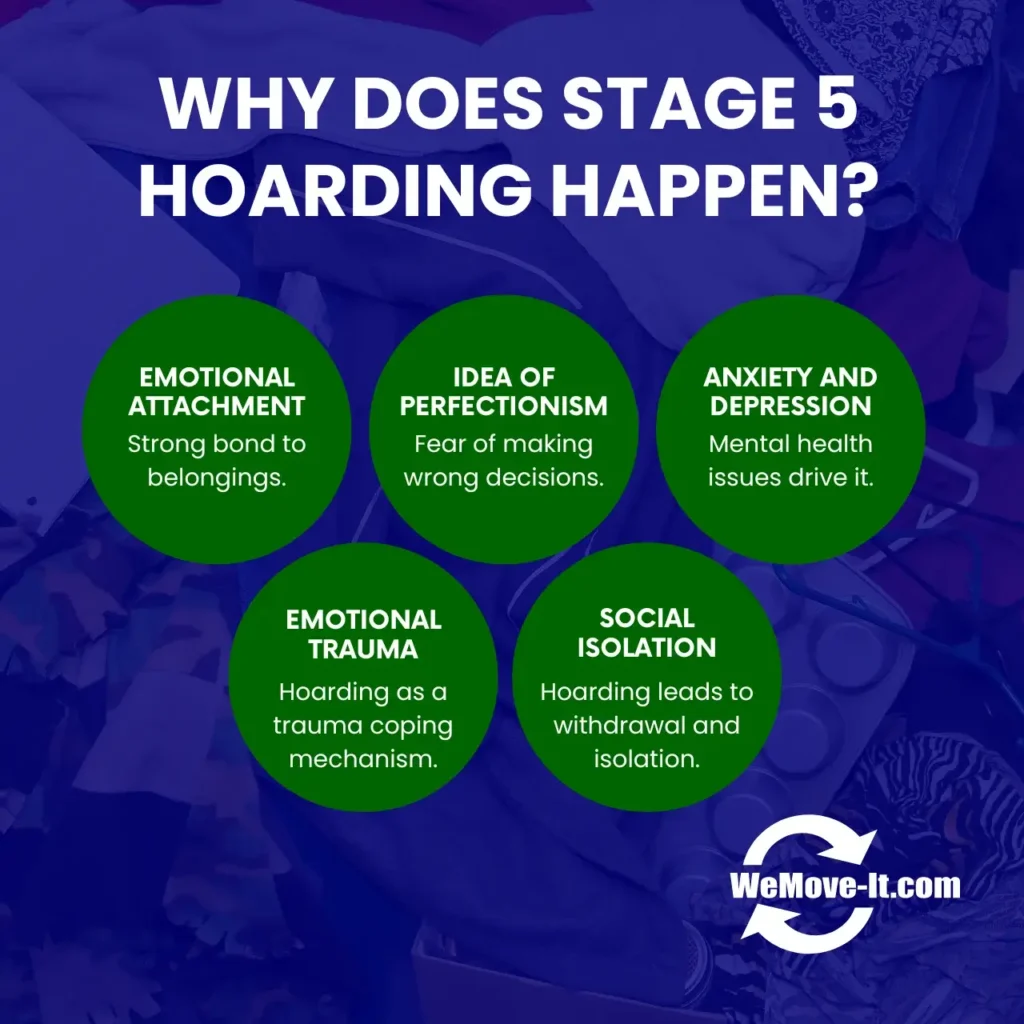
Hoarding is a complex condition, and reaching Stage 5 doesn’t happen overnight. It’s the result of years, or even decades, of accumulated possessions and the inability to let go. A person may reach this level for several reasons:
- Emotional Attachment: People who hoard often have a deep emotional attachment to their belongings. Each item might hold a specific memory or significance, making it extremely difficult to discard.
- Perfectionism: Many hoarders struggle with perfectionism, which can make decision-making overwhelming. They might fear making the wrong choice about what to keep or throw away, leading them to keep everything.
- Anxiety and Depression: Mental health conditions such as anxiety and depression are closely linked to hoarding. The thought of letting go of possessions can trigger severe anxiety, while depression can lead to a lack of motivation to clean up.
- Trauma: Some people begin hoarding as a way to cope with trauma or loss. The possessions provide a sense of security or control in an otherwise chaotic life.
- Social Isolation: Over time, hoarding can lead to social isolation. The embarrassment of having others see the condition of their home may cause individuals to withdraw, further worsening the situation.
The Dangers of Stage 5 Hoarding
Stage 5 hoarding isn’t just about clutter- it poses real dangers. The risk of fire is incredibly high due to blocked exits, flammable materials, and potential electrical issues. According to the National Fire Protection Association (NFPA), homes affected by hoarding conditions are more susceptible to fires, and such fires are more challenging for firefighters to control due to the excess clutter. The NFPA reports that hoarding conditions contribute to increased fire deaths, injuries, and damage compared to homes without hoarding.

Here are some other risks:
- The air quality in the home can be severely compromised by dust, mold, and other allergens, leading to respiratory problems. Studies show that people living in hoarding conditions are more likely to suffer from chronic respiratory issues, such as asthma and bronchitis.
- Rodent and insect infestations are common, bringing with them the threat of disease. The Centers for Disease Control and Prevention (CDC) notes that hoarding situations often create environments where diseases like Hantavirus, spread by rodents, can thrive.
- Structural damage can make the home unsafe to live in, and in some cases, local authorities may condemn the property, forcing the individual to leave.
- The financial burden of hoarding can also be significant, with some individuals facing foreclosure due to the uninhabitable condition of their homes.
People with Stage 5 hoarding often experience extreme shame, guilt, and hopelessness. They may feel trapped by their belongings, unable to see a way out. This can lead to worsening mental health, including depression and anxiety, and can even contribute to suicidal thoughts. In fact, individuals with severe hoarding disorder are at an increased risk of suicidal ideation due to the overwhelming nature of their living conditions and the social isolation that often accompanies it.
How to Help Someone with Stage 5 Hoarding
If you or someone you care about is dealing with Stage 5 hoarding, it’s important to approach the situation with compassion and understanding. Here are some steps you can take:
- Start with a Conversation: Open a dialogue without judgment. Express your concern for their well-being and let them know that help is available. Avoid making accusations or demanding immediate changes, as this can lead to resistance.
- Encourage Professional Help: Level 5 hoarding requires professional intervention. Mental health professionals who work with hoarding can help address the underlying issues, while professional cleanup services can handle the physical aspects safely.
- Offer Support: Let the person know that you’re there to support them through the process. Whether it’s helping them find resources or simply being there to listen, your support can make a big difference.
- Be Patient: Recovery from hoarding doesn’t happen overnight. It’s a gradual process that requires time, patience, and understanding. Celebrate small victories along the way, and continue to offer encouragement to the person.
Cleaning up a Stage 5 hoarding situation is not something you should attempt on your own. It requires specialized equipment and knowledge to safely handle biohazards and other dangers. A professional hoarder clean-up service like WeMove-It.com can help manage extreme cases in Hamilton and Toronto to restore the home to a safe and livable condition.
Let Us Help You Address Level 5 Hoarding
Living with or witnessing Stage 5 hoarding can be incredibly challenging, but it’s important to remember that help is available. Whether you’re reaching out for yourself or a loved one, taking the first step can help improve health, safety, and quality of life.If you or someone you know is facing a Stage 5 hoarding situation, don’t hesitate to seek professional help.
WeMove-It.com offers compassionate support and are expert hoarder cleanup specialists that can make the cleanup more manageable. To schedule your free estimate, contact us today.
